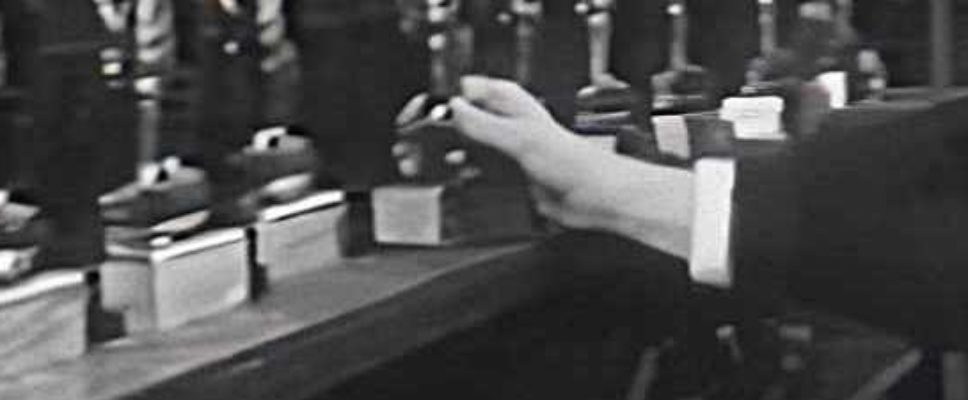Teresa Reviews “Ten Little Indians” (1959): Kill ‘Em Quick
Fidelity to text: 4 1/2 weapons
 This version is truer to the novel than the stage play. However, our hero and heroine still escape, but with a backstory much closer to the novel.
This version is truer to the novel than the stage play. However, our hero and heroine still escape, but with a backstory much closer to the novel.
Quality of movie on its own: 4 weapons
 The quality of the film is terrible. Blurry, out of focus, poor sound so you can’t be sure what was just said. Otherwise, wow.
The quality of the film is terrible. Blurry, out of focus, poor sound so you can’t be sure what was just said. Otherwise, wow.

Since it’s not filmed on a stage, but rather on set, the camera is free to move around a little more than it otherwise would. The relatively static location helps increase tension. The camera is as trapped as the unlucky recipients of U. N. Owen’s invitation.
One hour long! Think about that. The stage presentation is probably two hours or more. I couldn’t find any mention of how long a performance runs — probably because it varies so much depending on the speed of the actors — but I’m very sure it’s longer than one hour.
Yet in that hour, the screenwriter (Philip H. Reisman jr.) worked in all ten victims plus the boatman. The action is compressed into a single traumatic evening and terrified morning. The cast arrives, ferried to the island by the boatman, and discover what’s in store for them. The script provides insight into most of the victims ranging from snapshot to documentary; their motivation, their struggle, their self-justification, and their comeuppance.
Mrs. Rogers, the cook married to the butler, gets the least air time of the ten but she’s also the least culpable of the murderers. In the novel and stage versions, it’s reasonably clear that she did what her husband told her and has felt guilty ever since. That’s why she dies so quickly and easily.

Rogers, the butler, goes next. He’s a cold, cold man here, not the comic figure in the 1945 film. He’s able to fully justify his actions, claiming that he tried to save the mistress, even racing out into the stormy night to do so, and failing.

Emily Brent is up next. She’s self-righteous to a fare-thee-well, going so far as to tell Vera that she’s inappropriately dressed. Vera is wearing a staid, black fitted dress with a white collar but the way Emily Brent talks, you’d think Vera’s dress was painted on with a neckline down to there. Detective Blore says it best (I’m paraphrasing because the sound quality was poor): Emily Brent could be strutting naked onboard an Albanian freighter and the sailors would leave her alone.

If you can’t believe Judge Wargrave, nothing else in the story works. The only flaw in this film with Judge Wargrave is it was hard to believe he moved so fast without anyone noticing. Compressing the action to a single night and a morning didn’t leave him much time to seduce Dr. Armstrong, lay false trails, sow fear and discontent, and in general panic and mislead the other victims without being detected. I’m still not sure how he offed Emily Brent and no one noticed. But that’s a minor quibble.
In this version, Dr. Armstrong, who should be a more dramatic character, fades in comparison to Judge Wargrave. He needed more time to fear, to panic, to accept the lifeline tossed to him by the judge. Detective Blore, who got off many of the best lines, also needed more time but alas, there was none.

Philip Lombard was better served in this version too. He’s himself and not some pal stepping in to see what’s going on. Like Vera, two stories are floating around about him: the scurrilous false one and the sad true one. Which one do the gossips chose? You can guess the answer.
The real flaw with this film was the film itself. Kinescope was a way of filming a live performance to be broadcast on television. It was never meant as a permanent record. It’s blurry. The dialog is often unclear. You’ll have to watch a scene twice or even three times to figure out what’s being said. Luckily, that’s no hardship.
Don’t bypass this version of And Then There Were None because of the film stock. The script is so good, it should be remade just as it is.

